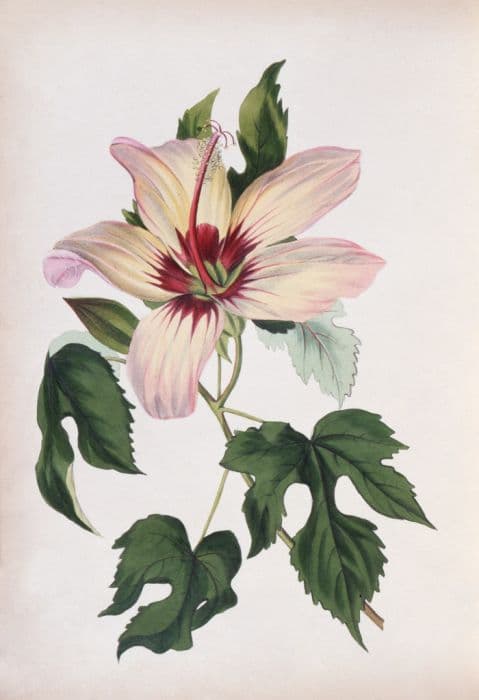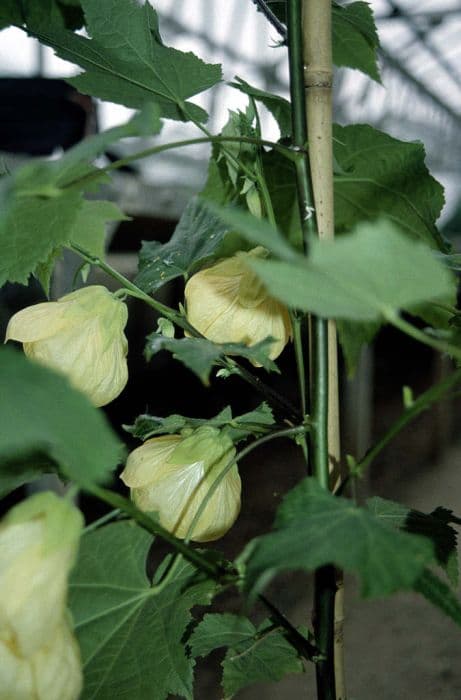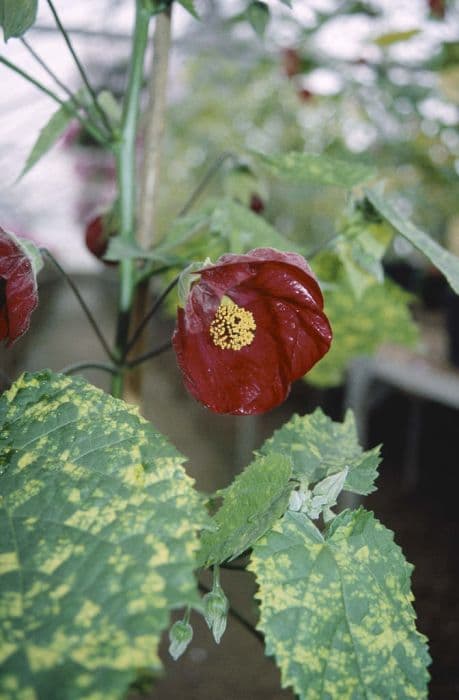Rose of Sharon Hibiscus syriacus 'Éléonore' (PBR)

ABOUT
The Hibiscus syriacus 'Éléonore' (PBR), commonly known as Rose of Sharon, is a flowering shrub that is notable for its attractive blooms. The flowers of 'Éléonore' boast a soft, pale hue, often pink or lavender in color, and have a prominent, darker-colored center that provides a striking contrast against the lighter petals. These blooms are generally large, with a ruffled, sometimes almost frilly appearance that adds a romantic touch to the plant's overall aesthetic. The foliage of the Rose of Sharon 'Éléonore' consists of broad, heart-shaped leaves that are a lush green color, creating a dense canopy that can provide a visual backdrop for the flowers. The leaves can have a glossy texture, catching the light and adding vibrancy to the plant's appearance. During its blooming season, the 'Éléonore' variety becomes a focal point in the landscape, drawing attention with its repeated flowering that can last from mid-summer through early fall. The plant itself typically has an upright, vase-shaped habit, forming a structural element in garden designs even when not in bloom. Overall, the Hibiscus syriacus 'Éléonore' (PBR) Rose of Sharon presents a charming display of delicate flowers set against sturdy, attractive foliage, making it a popular choice for ornamental use in a variety of garden settings.
About this plant
 Names
NamesFamily
Malvaceae.
Synonyms
Rose Of Sharon, Shrub Althea, Syrian Ketmia, Hardy Hibiscus.
Common names
Hibiscus syriacus 'Éléonore' (PBR)
 Toxicity
ToxicityTo humans
The Rose of Sharon is generally considered to be non-toxic to humans and ingestion of parts of the plant typically does not result in serious poisoning. However, as with any plant material, individual sensitivities can vary, and consumption in large quantities could potentially cause stomach upset or discomfort.
To pets
The Rose of Sharon is also generally considered to be non-toxic to pets, including cats and dogs. Similar to humans, ingestion of this plant is not expected to cause serious harm, but it may lead to mild gastrointestinal upset, such as vomiting or diarrhea, in some pets if consumed in significant amounts. It is always advisable to monitor your pets around plants and discourage them from eating plant material.
 Characteristics
CharacteristicsLife cycle
Perennials
Foliage type
Deciduous
Color of leaves
Green
Flower color
Pink
Height
8-12 feet (2.4-3.7 meters)
Spread
6-10 feet (1.8-3 meters)
Plant type
Shrub
Hardiness zones
5-8
Native area
Asia
Benefits
 General Benefits
General Benefits- Attractive Flowers: Hibiscus syriacus 'Éléonore' offers large, showy blooms that can add visual appeal to any garden or landscape design.
- Long Blooming Season: It blooms over a lengthy period, often from mid-summer to early fall, extending the period of visual interest in the garden.
- Drought Tolerance: Once established, this plant has good drought tolerance, making it a suitable choice for gardens in drier climates or for water-wise landscaping.
- Cold Hardiness: It is relatively cold hardy, able to withstand cooler temperatures, which makes it versatile for growing in a range of climates.
- Low Maintenance: The plant typically requires minimal care once established, aside from occasional pruning to maintain shape and promote vigorous growth.
- Attracts Pollinators: Its flowers are attractive to bees, butterflies, and other pollinators, thus supporting local biodiversity.
- Privacy Screen: With its dense growth habit, Hibiscus syriacus 'Éléonore' can be used as an informal hedge or privacy screen in the garden.
- Versatility: Can be grown as a stand-alone specimen, in mass plantings, or as part of a mixed border, offering flexibility in garden design.
 Medical Properties
Medical PropertiesThis plant is not used for medical purposes.
 Air-purifying Qualities
Air-purifying QualitiesThis plant is not specifically known for air purifying qualities.
 Other Uses
Other Uses- Haircare Products: Hibiscus syriacus 'Éléonore', also known as Rose of Sharon, can be used in shampoos and conditioners, as the flowers are believed to contribute to the health and shine of hair.
- Edible Delicacies: The flowers and young leaves are sometimes used in salads or as garnishes, adding a unique, mild flavor and a touch of elegance to culinary dishes.
- Natural Fabric Dye: The petals of Rose of Sharon can be used to create natural dyes for fabric, yielding soft shades of pink, purple, or blue depending on the mordant used.
- Tea Flavoring: Dried Rose of Sharon flowers can be infused to make a soothing herbal tea with a subtle floral taste, often enjoyed for its unique flavor.
- Symbolic Gift: In some cultures, giving someone a Rose of Sharon may be symbolic of conveying love or interest, making it a thoughtful non-verbal gesture of affection.
- Art and Illustration: The beauty and diverse colors of Rose of Sharon blooms make them popular subjects for botanical art, garden illustrations, and photography projects.
- Handmade Paper: The fibers of Rose of Sharon's bark can be used in the production of high-quality, textured handmade paper, valued for its uniqueness and craftsmanship.
- Landscape Design: Apart from its aesthetic appeal, Rose of Sharon can be used as a natural privacy screen or hedge when planted in rows, due to its bushy growth habit.
- Eco-friendly Insect Deterrent: Some gardeners plant Rose of Sharon as part of a companion planting strategy, believing that its presence can deter certain types of garden pests.
- Cultural Ceremonies: In some traditions, the Rose of Sharon is used in wedding ceremonies or religious events to symbolize purity and peace.
Interesting Facts
 Feng Shui
Feng ShuiThe Rose of Sharon is not used in Feng Shui practice.
 Zodiac Sign Compitability
Zodiac Sign CompitabilityThe Rose of Sharon is not used in astrology practice.
 Plant Symbolism
Plant Symbolism- Beauty: The Hibiscus syriacus, also known as Rose of Sharon, is often associated with beauty due to its large, colorful blossoms that can add aesthetic appeal to any garden.
- Femininity: The soft and delicate nature of the Rose of Sharon’s flowers symbolizes gentle feminine qualities.
- Love: In South Korea, where the Rose of Sharon is the national flower, it represents the enduring nature of love and is associated with the loyalty and passion found within romantic relationships.
- Renewal: Since the Rose of Sharon is capable of surviving harsh winters and still producing stunning flowers each year, it symbolizes rebirth and the ability to overcome tough challenges.
 Water
WaterThe Rose of Sharon should be watered deeply, allowing the soil around the root zone to become moist but not saturated. During the growing season, it's typically necessary to water the plant once a week, providing about 1 to 1.5 gallons of water each time, depending on the weather conditions and soil drainage. If there's a period of drought or extreme heat, increase the watering frequency to twice a week. Over the fall and winter months, reduce watering as the plant enters dormancy. Always check the soil moisture level before watering to avoid overwatering, which can lead to root rot.
 Light
LightThe Rose of Sharon thrives in full sun to partial shade conditions. The ideal spot for this plant is where it receives at least six hours of direct sunlight a day. While the plant can tolerate some light shade, too little sunlight can result in fewer flowers and a leggy growth habit.
 Temperature
TemperatureThe Rose of Sharon is quite hardy and can withstand temperatures as low as 20°F, although it performs best in temperatures that range from 60°F to 90°F. The plant can survive hot summers and is cold hardy up to USDA zone 5, making it adaptable to many climates as long as the extreme temperatures do not persist for long periods.
 Pruning
PruningPruning the Rose of Sharon encourages bushier growth and more blooms. The best time to prune is in late winter or early spring before new growth begins. Prune to remove dead or damaged branches and to shape the plant. It can be pruned annually to maintain its size or desired form, but it can also be left to grow more naturally with less frequent pruning.
 Cleaning
CleaningAs needed
 Soil
SoilThe Rose of Sharon requires well-draining soil rich in organic matter with a pH ranging from 6.0 to 7.5. A mix of two parts loam, one part peat moss, and one part perlite or sand is ideal to ensure good drainage and fertility.
 Repotting
RepottingRose of Sharon is typically grown as a shrub in the garden and does not require frequent repotting. If potted, young plants may need repotting every 2-3 years to encourage growth.
 Humidity & Misting
Humidity & MistingRose of Sharon thrives in average outdoor humidity conditions and does not require any special humidity adjustments.
 Suitable locations
Suitable locationsIndoor
Ensure bright light, well-draining soil, and room to grow.
Outdoor
Plant in sunny spot, ensure moist, well-draining soil.
Hardiness zone
Rose of Sharon is suitable for USDA zones 5-8.
 Life cycle
Life cycleHibiscus syriacus 'Éléonore', commonly known as Rose of Sharon, begins its life cycle with seed germination, which occurs in warm, moist soil conditions typically in late spring or early summer. Following germination, seedlings establish themselves, developing a root system and foliage during their first growing season. As a perennial, the plant enters a vegetative stage, producing woody stems and larger leaves, and with each subsequent year, it develops more branches and foliage. The flowering stage typically starts in the second year and continues each year from late summer to fall, with blossoms that can be blue, pink, or white depending on the variety. After pollination, the flowers develop into seed pods that ripen and release seeds, continuing the reproductive cycle. During the winter months, the plant may enter a period of dormancy, shedding leaves and conserving energy until the next growing season.
 Propogation
PropogationPropogation time
Spring-Early Summer
The most popular method of propagating the Hibiscus syriacus 'Éléonore', commonly known as Rose of Sharon, is through softwood cuttings. This is usually done in late spring to early summer, when the plant’s new growth is tender but has not yet hardened. Cuttings should be about 4 to 6 inches (10 to 15 centimeters) long and should include at least two sets of leaves. The lower leaves are removed, and the cut end dipped in rooting hormone to encourage root development. The prepared cutting is then inserted into a pot filled with a mix of peat and perlite, ensuring at least one set of leaves remains above the surface. The pot should be kept in indirect sunlight and maintained with consistent moisture. Under the right conditions, roots will develop in a few weeks, and the cutting can be eventually transplanted outdoors.









